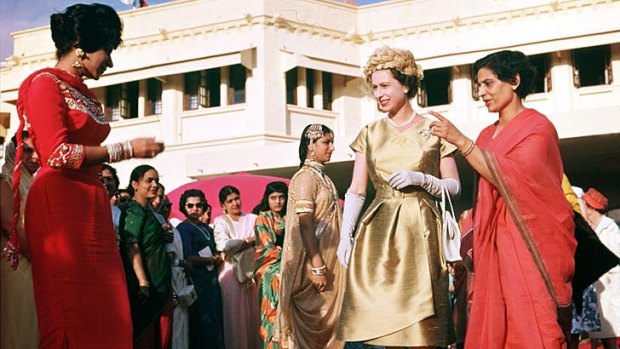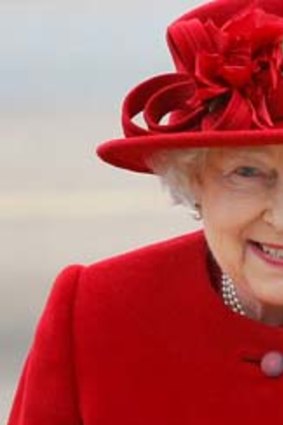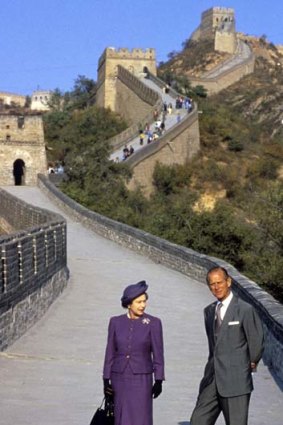
Royal road... the Queen visits Pakistan in 1961.Credit: Getty Images
Is there anywhere the Queen hasn't been? Yes, writes Sophie Campbell — the passport queue at Heathrow.
In 1966, my brother, aged seven, sent a penny to Queen Elizabeth. It came back with a gracious thank-you letter from a lady-in-waiting explaining that, sadly, her majesty was unable to accept it. We were aghast. Not allowed to have any pocket money? Surely the Queen could do anything she wanted?
In many ways the same paradox applies to her travel: she can do everything and nothing. In 60 years on the throne, she has made 261 official overseas visits and 96 state visits to 116 countries. She is the most-travelled head of state in the world and must be a contender for the most-travelled human being: there can't be many business travellers or pilots who have worked for six decades.
She has seen the best every country has to offer and received wonderful gifts, a number of which are now in London Zoo. But think of all the things she hasn't been able to do that most of us take for granted. She has never stood in a queue at Heathrow to have her passport inspected (she doesn't have one) or been busted for having oversize hand luggage. She has never rented a car, shared a bus with chickens, nipped into a bar for a spur-of-the-moment swift half or been to a bureau de change. She may never have handled foreign currency, unless newly minted. Who was it who said the world for her is a place smelling of fresh paint?
Certainly, that world has changed beyond recognition for the Queen, and the rest of us, since she took her first trip to South Africa with her parents and Princess Margaret in 1947. There is BBC archive footage online of hundreds of people turning out on a bitterly cold January day to wave off the royal car, which drove to the royal train, which took them to a snow-caked ship at Southampton. Tiny shreds of sound and the odd royal vowel are drowned out by the patriotic music.
It is difficult to imagine how exotic it all must have seemed to a public for whom holidays, if they got them at all, meant a few days at the seaside. When images were shown in 1952 of Princess Elizabeth and Prince Philip at Sagana Lodge, "Keen-ya" (their stay a delayed wedding present from the Kenyan government), and watching the wildlife from the canopy at Treetops Hotel in nearby Aberdare National Park, few could have dreamt of seeing Africa's animals. In those pre-David Attenborough days, people wouldn't have seen animals on television, either.

The Queen at Holyhead, Wales.Credit: Getty Images
That view, high in the acacias, was the princess's last glimpse of freedom: her father died in the night and the next morning she was queen. The London Telegraph's royal travel archive consists of boxes of buff folders held together with tags containing thousands of slips of brittle, yellowed paper on to which are pasted cuttings.
The reporting was reverential, particularly during the build-up to the 173-day Commonwealth Coronation Tour of 1953. The new royal yacht Britannia was not quite ready, so the couple would fly to Bermuda on a BOAC Stratocruiser Canopus, then take the steamship Gothic to New Zealand. Britannia, designed to be converted to a hospital ship in times of war, would take them home from Tobruk, Libya, after the tour.
For months beforehand, snippets appeared about the schedule, weather and transport. The tone is solicitous, almost anxious, perhaps understandably: Elizabeth was the fourth monarch on the throne in less than 20 years and had two young children she would have to leave behind for six months. "One slender ground for anxiety remains," wrote an MP to the newspaper, "that the Queen should not by her exertions overtax her strength. The Australian tour ... involves flying vast distances at the very height of the southern summer."

Queen Elizabeth and Prince Philip on the Great Wall of China in 1986.Credit: Getty Images
By departure day, which was November 23, the headlines had become a blizzard: "Queen off tonight at 8.45", "Weather for first stage favourable", "Final check up on Stratocruiser", "4770 miles in 42 hours with day in Bermuda".
A map of the route was printed. Royal Navy ships were stationed across the Atlantic. Racegoers at Sandown Park shouted "Bon voyage!" and Hartnell's delivered the Queen's dresses to the palace: the only details released, for fear of copying, were the colours - candy pink, pale rose, blue, yellow and white - and that some dresses were cotton print and others contained up to 100 yards of tulle. In Kensington, police had to hold back crowds running after the car.
As the years and the tours went by, enticing details of foreign countries and people - often couched in terms that make toes curl today - filtered back. The "Negro spreads coat" incident in Kingston, for example, when a courtly Jamaican laid his coat down in front of the Queen, like Sir Walter Raleigh, and was promptly arrested (he was later released), or the Queen's tea with the favourite wife of Sheikh Zayed of Abu Dhabi, "whose face is said to have been seen only by three men in her life, her father, brother and husband". The editorial tone of amused tolerance turned quickly to chilly disapproval if it was felt that the appropriate respect or gratitude was not being shown.
The first "walkabout" took place in Australia in 1970 and was a rip-roaring success. But as the decade wore on, mass air travel arrived, attitudes shifted and writers took a less dutiful line. There were rumblings about the cost of royal travel, then there was spectacular geopolitical change - from the fall of the Berlin Wall in 1989 to the slow wind-down of the Irish Troubles. Domestic difficulties included divorcing children and an angrier, less reverent nation.
Despite all the difficulties, the show went on, like a royal train chugging over the ups and downs. Britannia, after all those years of waiting faithfully for her mistress in ports all over the world, was retired in 1997, unlike the Queen and Prince Philip, who have maintained a ferocious pace at home and abroad. The best summing-up of their travels, perhaps, was given in 2005 by the BBC's Justin Webb, who intoned over an image of Britannia: "There she is, 100,000 miles on the clock and still looking pretty serviceable" - only to find the camera had switched to the Queen.
Bang on, but for the pitifully low mileage.
Souvenirs of royal life:
- A grass skirt and whales' teeth from Fiji.
- A silver dhow from the Emir of Kuwait.
- Mother-of-pearl necklaces from Tuvalu.
- A shell collection from the Seychelles.
- Cowboy boots from the US.
- An elephant, Jumbo, from Cameroon.
- A Maori canoe from New Zealand.
- An ice-hockey shirt from Canada.
- Telegraph, London
Sign up for the Traveller Deals newsletter
Get exclusive travel deals delivered straight to your inbox. Sign up now.